
Paris, France | AFP | The 2015 Paris Agreement, which the United States will quit according to President Donald Trump’s announcement on Thursday, is the first pact to commit all nations to limiting global warming caused by emissions from burning coal, oil and gas.
Key facts about the pact:
– The climate club –
A total of 196 nations, including the Palestinian authorities, have endorsed the agreement and 147 have officially ratified it.
The accord entered into force in record time on November 4, 2016, when it crossed the threshold of 55 ratifying parties representing 55 percent of global greenhouse gas emissions.
China, the world’s number one greenhouse gas polluter and Europe, number three after the US in second place, recommitted to the Paris Agreement Thursday.
The biggest polluter not to have ratified the deal is Russia (number five after India).
– Rules of engagement –
The agreement makes provision for parties to quit, but notice can be given only three years after its entry into force.
Withdrawal would take effect a year after that. But on Thursday, Trump said the US would “cease all implementation” of the accord “as of today.”
A country can also withdraw from the 1992 UN Framework Convention on Climate Change (UNFCCC) under whose auspices the deal was negotiated. Withdrawal would take effect a year after notification, which can be given at any moment.
– The goal –
Nations agreed to hold global warming to “well below” two degrees Celsius (3.6 degrees Fahrenheit) over pre-Industrial Revolution levels, and to strive for a lower limit of 1.5 degrees.
Experts say even the two-degree ceiling is a tall order, requiring an immediate and deep reduction in planet-warming emissions from fossil fuels — an industry with major influence in Washington.
Signatories to the deal will aim for emissions to peak “as soon as possible”. The UN’s climate science panel recommends a 40-70-percent cut by 2050 from 2010 levels.
Based on voluntary pledges by countries so far, the planet is on track for warming of about three degrees, many scientists say — a recipe for catastrophic floods, storms, drought and sea-level rise.
– Tracking progress –
In 2018, and every five years thereafter, countries will take stock of the overall impact of their efforts to rein in global warming.
Some nations, including the United States, set emissions-curbing targets for 2025, others for 2030. Both categories must be updated every five years starting 2020.
– Financing –
Rich countries are expected to provide funding to help developing countries make the costly shift to cleaner energy sources and to shore up defences against the impacts of climate change.
They have committed $100 billion (89 billion euros) per year by 2020.
But Trump on Thursday said that the United States, which pledged $3 billion towards the Green Climate Fund of which it delivered $1 billion under Obama, would not implement financial commitments or national emissions-curbing measures pledged under the pact.
 The Independent Uganda: You get the Truth we Pay the Price
The Independent Uganda: You get the Truth we Pay the Price



